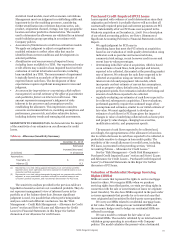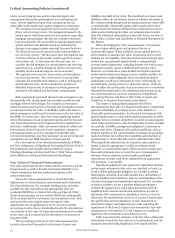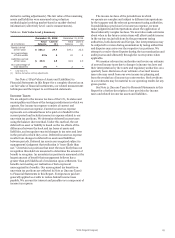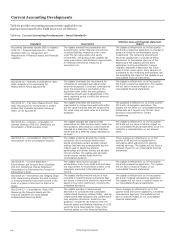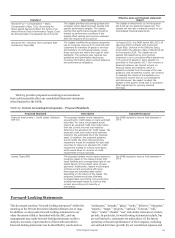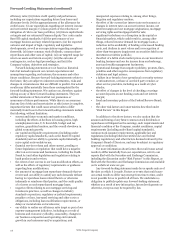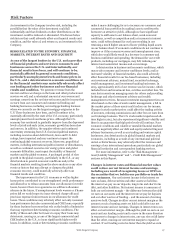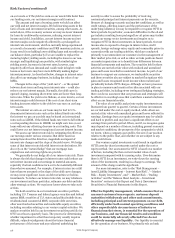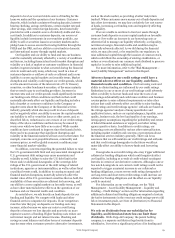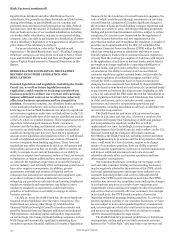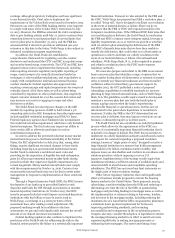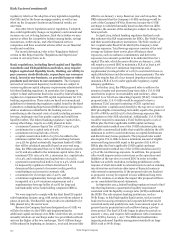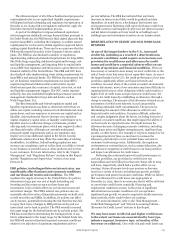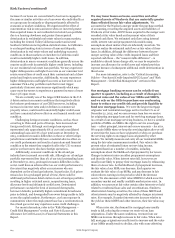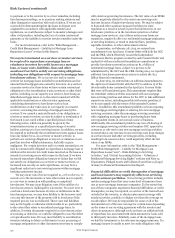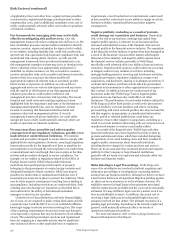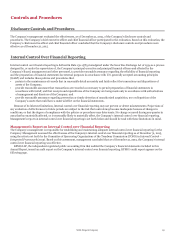Wells Fargo 2015 Annual Report Download - page 123
Download and view the complete annual report
Please find page 123 of the 2015 Wells Fargo annual report below. You can navigate through the pages in the report by either clicking on the pages listed below, or by using the keyword search tool below to find specific information within the annual report.earnings, although proprietary trading has not been significant
to our financial results. Final rules to implement the
requirements of the Volcker Rule were issued in December 2013.
Pursuant to an order of the FRB, banking entities were required
to comply with many of the Volcker Rule’s restrictions by July
21, 2015. However, the FRB has extended the rule’s compliance
date to give banking entities until July 21, 2016 to conform their
ownership interests in and sponsorships of covered funds that
were in place prior to December 31, 2013, and the FRB has
announced that it intends to provide an additional one-year
extension to this date in the future. Wells Fargo is also subject to
enhanced compliance program requirements.
In addition, the Dodd-Frank Act established a
comprehensive framework for regulating over-the-counter
derivatives and authorized the CFTC and SEC to regulate swaps
and security-based swaps, respectively. The CFTC and SEC have
adopted various rules to implement this framework, including
rules requiring extensive regulatory and public reporting of
swaps, certain swaps to be centrally cleared and traded on
exchanges or other multilateral platforms, and swap dealers to
comply with comprehensive internal and external business
conduct standards. Federal regulators also approved rules
requiring certain margin and capital requirements for swaps not
centrally cleared. All of these rules, as well as others being
considered by regulators in other jurisdictions, may negatively
impact customer demand for over-the-counter derivatives and
may increase our costs for engaging in swaps and other
derivatives activities.
The Dodd-Frank Act also imposes changes on the ABS
markets by requiring sponsors of ABS to hold at least a 5%
ownership stake in the ABS. Exemptions from the requirement
include qualified residential mortgages and FHA/VA loans.
Federal regulatory agencies have finalized rules to implement
this credit risk retention requirement, which have only included
limited exemptions. The final rules may impact our ability to
issue certain ABS or otherwise participate in various
securitization transactions.
In order to address the perceived risks that money market
mutual funds may pose to the financial stability of the United
States, the SEC adopted rules in July 2014 that, among other
things, require significant structural changes to these funds,
including requiring non-governmental institutional money
market funds to maintain a variable net asset value and
providing for the imposition of liquidity fees and redemption
gates for all non-governmental money market funds during
periods in which they experience liquidity impairments of a
certain magnitude. Money market mutual funds must comply
with these requirements by October 14, 2016. Certain of our
money market mutual funds may see a decline in assets under
management in response to implementation of these structural
changes.
Through a Deposit Insurance Fund (DIF), the FDIC insures
the deposits of our banks up to prescribed limits for each
depositor and funds the DIF through assessments on member
insured depository institutions. In October 2015, the FDIC
issued a proposed rule that would impose on insured depository
institutions with $10 billion or more in assets, such as
Wells Fargo, a surcharge of 4.5 cents per $100 of their
assessment base, after making certain adjustments. The
proposed surcharge would be in addition to the base
assessments we pay and could significantly increase the overall
amount of our deposit insurance assessments.
Federal banking regulators also continue to implement the
provisions of the Dodd-Frank Act addressing the risks to the
financial system posed by the failure of a systemically important
financial institution. Pursuant to rules adopted by the FRB and
the FDIC, Wells Fargo has prepared and filed a resolution plan, a
so-called “living will,” that is designed to facilitate our resolution
in the event of material distress or failure. There can be no
assurance that the FRB or FDIC will respond favorably to the
Company’s resolution plans. If the FRB and FDIC determine that
our resolution plan is deficient, the Dodd-Frank Act authorizes
the FRB and FDIC to impose more stringent capital, leverage or
liquidity requirements on us or restrict our growth or activities
until we submit a plan remedying the deficiencies. If the FRB
and FDIC ultimately determine that we have been unable to
remedy the deficiencies, they could order us to divest assets or
operations in order to facilitate our orderly resolution in the
event of our material distress or failure. Our national bank
subsidiary, Wells Fargo Bank, N.A., is also required to prepare
and submit a resolution plan to the FDIC under separate
regulatory authority.
We must also prepare and submit to the FRB on an annual
basis a recovery plan that identifies a range of options that we
may consider during times of idiosyncratic or systemic economic
stress to remedy any financial weaknesses and restore market
confidence without extraordinary government support. In
December 2015, the OCC published a notice of proposed
rulemaking on guidelines to establish standards for recovery
planning by large insured national banks, such as Wells Fargo
Bank, N.A. The guidelines would require a bank to develop and
maintain a recovery plan that sets forth the bank’s plan to
remain a going concern when the bank is experiencing
considerable financial or operational stress, but has not yet
deteriorated to the point where liquidation or resolution is
imminent. If either the FRB or the OCC determine that our
recovery plan is deficient, they may impose restrictions on our
business or ultimately require us to divest assets.
The Dodd-Frank Act also establishes an orderly liquidation
process which allows for the appointment of the FDIC as a
receiver of a systemically important financial institution that is
in default or in danger of default. The FDIC has issued rules to
implement its orderly liquidation authority and released a notice
and request for comment regarding a proposed resolution
strategy, known as “single point of entry,” designed to resolve a
large financial institution in a manner that holds management
responsible for its failure, maintains market stability, and
imposes losses on shareholders and creditors in accordance with
statutory priorities, without imposing a cost on U.S.
taxpayers. Implementation of the strategy would require that
institutions maintain a sufficient amount of available equity and
unsecured debt to absorb losses and recapitalize operating
subsidiaries. The FDIC has not issued any final statements on
the single point of entry resolution strategy.
Other future regulatory initiatives that could significantly
affect our business include proposals to reform the housing
finance market in the United States. These proposals, among
other things, consider winding down the GSEs and reducing or
eliminating over time the role of the GSEs in guaranteeing
mortgages and providing funding for mortgage loans, as well as
the implementation of reforms relating to borrowers, lenders,
and investors in the mortgage market, including reducing the
maximum size of a loan that the GSEs can guarantee, phasing in
a minimum down payment requirement for borrowers,
improving underwriting standards, and increasing
accountability and transparency in the securitization process.
Congress also may consider the adoption of legislation to reform
the mortgage financing market in an effort to assist borrowers
experiencing difficulty in making mortgage payments or
refinancing their mortgages. The extent and timing of any
Wells Fargo & Company
121


